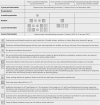Effectiveness of policy to provide breastfeeding groups (BIG) for pregnant and breastfeeding mothers in primary care: cluster randomised controlled trial
- PMID: 19181729
- PMCID: PMC2635594
- DOI: 10.1136/bmj.a3026
Effectiveness of policy to provide breastfeeding groups (BIG) for pregnant and breastfeeding mothers in primary care: cluster randomised controlled trial
Abstract
Objective: To assess the clinical effectiveness and cost effectiveness of a policy to provide breastfeeding groups for pregnant and breastfeeding women.
Design: Cluster randomised controlled trial with prospective mixed method embedded case studies to evaluate implementation processes.
Setting: Primary care in Scotland.
Participants: Pregnant women, breastfeeding mothers, and babies registered with 14 of 66 eligible clusters of general practices (localities) in Scotland that routinely collect breastfeeding outcome data.
Intervention: Localities set up new breastfeeding groups to provide population coverage; control localities did not change group activity.
Primary outcome: any breast feeding at 6-8 weeks from routinely collected data for two pre-trial years and two trial years.
Secondary outcomes: any breast feeding at birth, 5-7 days, and 8-9 months; maternal satisfaction.
Results: Between 1 February 2005 and 31 January 2007, 9747 birth records existed for intervention localities and 9111 for control localities. The number of breastfeeding groups increased from 10 to 27 in intervention localities, where 1310 women attended, and remained at 10 groups in control localities. No significant differences in breastfeeding outcomes were found. Any breast feeding at 6-8 weeks declined from 27% to 26% in intervention localities and increased from 29% to 30% in control localities (P=0.08, adjusted for pre-trial rate). Any breast feeding at 6-8 weeks increased from 38% to 39% in localities not participating in the trial. Women who attended breastfeeding groups were older (P<0.001) than women initiating breast feeding who did not attend and had higher income (P=0.02) than women in the control localities who attended postnatal groups. The locality cost was pound13 400 (euro14 410; $20 144) a year.
Conclusion: A policy for providing breastfeeding groups in relatively deprived areas of Scotland did not improve breastfeeding rates at 6-8 weeks. The costs of running groups would be similar to the costs of visiting women at home.
Trial registration: Current Controlled Trials ISRCTN44857041.
Conflict of interest statement
Competing interests: None declared.
Figures




Comment in
-
Promoting breast feeding in the community.BMJ. 2009 Jan 30;338:a2657. doi: 10.1136/bmj.a2657. BMJ. 2009. PMID: 19181728 No abstract available.
Similar articles
-
Effectiveness of a breastfeeding peer coaching intervention in rural Scotland.Birth. 2006 Mar;33(1):27-36. doi: 10.1111/j.0730-7659.2006.00071.x. Birth. 2006. PMID: 16499529
-
Cluster randomised controlled trial of a financial incentive for mothers to improve breast feeding in areas with low breastfeeding rates: the NOSH study protocol.BMJ Open. 2016 Apr 11;6(4):e010158. doi: 10.1136/bmjopen-2015-010158. BMJ Open. 2016. PMID: 27067889 Free PMC article. Clinical Trial.
-
Clinical and cost-effectiveness of parenting intervention for mothers experiencing psychosocial stress: insights from the early closure of the Mellow Babies RCT.Public Health Res (Southampt). 2024 Dec;12(17):1-115. doi: 10.3310/KCVL7125. Public Health Res (Southampt). 2024. PMID: 39704733 Clinical Trial.
-
Schedules for home visits in the early postpartum period.Cochrane Database Syst Rev. 2021 Jul 21;7(7):CD009326. doi: 10.1002/14651858.CD009326.pub4. Cochrane Database Syst Rev. 2021. PMID: 34286512 Free PMC article.
-
Folic acid supplementation and malaria susceptibility and severity among people taking antifolate antimalarial drugs in endemic areas.Cochrane Database Syst Rev. 2022 Feb 1;2(2022):CD014217. doi: 10.1002/14651858.CD014217. Cochrane Database Syst Rev. 2022. PMID: 36321557 Free PMC article.
Cited by
-
The cost-effectiveness of antenatal and postnatal education and support interventions for women aimed at promoting breastfeeding in the UK.BMC Public Health. 2022 Jan 22;22(1):153. doi: 10.1186/s12889-021-12446-5. BMC Public Health. 2022. PMID: 35062928 Free PMC article.
-
Framework for the development and evaluation of complex interventions: gap analysis, workshop and consultation-informed update.Health Technol Assess. 2021 Sep;25(57):1-132. doi: 10.3310/hta25570. Health Technol Assess. 2021. PMID: 34590577 Free PMC article.
-
Support for healthy breastfeeding mothers with healthy term babies.Cochrane Database Syst Rev. 2012 May 16;5(5):CD001141. doi: 10.1002/14651858.CD001141.pub4. Cochrane Database Syst Rev. 2012. Update in: Cochrane Database Syst Rev. 2017 Feb 28;2:CD001141. doi: 10.1002/14651858.CD001141.pub5. PMID: 22592675 Free PMC article. Updated.
-
The Influence of Participation in Pregnancy Courses and Breastfeeding Support Groups on Attitudes and Knowledge of Health Professionals about Breastfeeding.Children (Basel). 2023 Mar 28;10(4):632. doi: 10.3390/children10040632. Children (Basel). 2023. PMID: 37189881 Free PMC article.
-
What can qualitative research do for randomised controlled trials? A systematic mapping review.BMJ Open. 2013 Jun 20;3(6):e002889. doi: 10.1136/bmjopen-2013-002889. BMJ Open. 2013. PMID: 23794542 Free PMC article.
References
-
- Ip S, Cheung M, Raman G, Chew P, Magula N, DeVine D, et al. Breastfeeding and maternal and infant health outcomes in developed countries. Rockville, MD: Agency for Healthcare Research and Quality, 2007. (Evidence report/technology assessment report No 153.) - PubMed
-
- Horta BL, Bahl R, Martines JC, Victora CG. Evidence of the long-term effects of breastfeeding. Geneva: WHO, 2007.
-
- WHO. Global strategy for infant and young child feeding. 2008. www.who.int/child_adolescent_health/topics/prevention_care/child/nutriti.... - PubMed
-
- Bolling K, Grant K, Hamlyn B, Thornton A. Infant feeding survey 2005. London: NHS Information Centre, 2007.
-
- Dyson L, McCormick F, Renfrew MJ. Interventions for promoting the initiation of breastfeeding. Cochrane Database Syst Rev 2005;(2):CDCD001688. - PubMed
Publication types
MeSH terms
Associated data
Grants and funding
LinkOut - more resources
Full Text Sources
Medical
